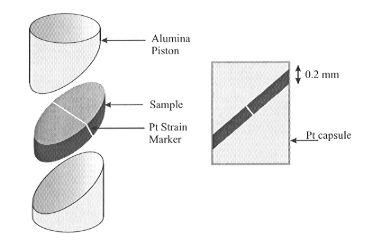

The origin of seismic anisotropy in the D" layer at the base of the Earth's mantle is poorly understood. Both experimental and theoretical studies have shown that (Mg,Fe)O in the deep portion of the lower mantle should have a large elastic anisotropy but in order to explain the seismic observations a strong lattice preferred orientation would also have to develop. Such a level of preferred orientation is unlikely if the dominant slip system in (Mg,Fe)O is {110}, as is observed at low pressures. Recent analysis by Karato, however, suggests that the slip systems in these oxides may change at high pressures due to a change in the nature of bonding, and the dominant glide plane may be {100}. If this theoretical prediction can be supported by experimental evidence, this would have significant ramifications for seismic anisotropy in the lower portions of the mantle.
In order to determine the dominant slip systems and to examine the deformation mechanisms, a series of oxide samples have been deformed in shear at high pressures and temperatures. Samples are deformed to large strains (up to 300%) at 15-16 GPa and 1600-1700 K using a multianvil apparatus. The shear design incorporates two alumina pistons cut at 45° with respect to their long axes making it possible to achieve significant strain and produce a strong fabric in the deformed samples (see 1997 Annual Report). Sample strains are determined from the rotation of a Pt marker that is initially oriented perpendicular to the sample/piston interface (Fig. 3.1-6). Lattice preferred orientation of the quenched samples is determined using electron back-scattering techniques.
Three end-member compositions (MgO, NiO and FeO) and two intermediate
compositions (Mg0.5Fe0.5)O and (Mg0.5Ni0.5)O
have been studied. All samples show significant deformation when deformed
at 14 GPa and 1300°C for 4 hours. Preliminary results indicate that
FeO is weaker than (Mg0.5Fe0.5)O as evidenced by
larger rotations of the Pt marker and significant flattening of grains.
Electron back-scattered imaging reveals the development of strong lattice
preferred orientation in both of these oxides.
 |
|
Fig. 3.1-6: The experimental capsule design for shear deformation
experiments performed to 17 GPa and 1800 K. A thin sample disk is placed
between two alumina pistons cut at 45 degrees. Each disk is cut in half
and a thin platinum strain marker is placed on each cut surface by vapour
deposition. |

Tel: +49-(0) 921 55 3700 / 3766, Fax: +49-(0) 921 55 3769, E-mail: bayerisches.geoinstitut(at)uni-bayreuth.de
 Previous page
Previous page